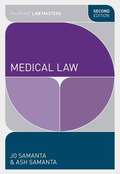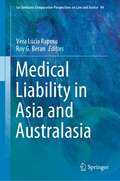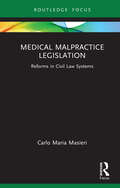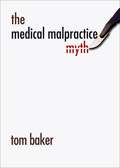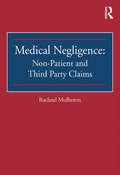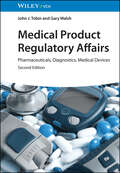- Table View
- List View
Medical Law in Malta
by Daniel BianchiDerived from the renowned multi-volume International Encyclopaedia of Laws, this convenient volume provides comprehensive analysis of the law affecting the physician-patient relationship in Malta. Cutting across the traditional compartments with which lawyers are familiar, medical law is concerned with issues arising from this relationship, and not with the many wider juridical relations involved in the broader field of health care law. After a general introduction, the book systematically describes law related to the medical profession, proceeding from training, licensing, and other aspects of access to the profession, through disciplinary and professional liability and medical ethics considerations and quality assurance, to such aspects of the physician-patient relationship as rights and duties of physicians and patients, consent, privacy, and access to medical records. Also covered are specific issues such as organ transplants, human medical research, abortion, and euthanasia, as well as matters dealing with the physician in relation to other health care providers, health care insurance, and the health care system. Succinct and practical, this book will prove to be of great value to professional organizations of physicians, nurses, hospitals, and relevant government agencies. Lawyers representing parties with interests in Malta will welcome this very useful guide, and academics and researchers will appreciate its comparative value as a contribution to the study of medical law in the international context.
Medical Law in Norway
by Karl Harald SøvigDerived from the renowned multi-volume International Encyclopaedia of Laws, this convenient volume provides comprehensive analysis of the law affecting the physician-patient relationship in Norway. Cutting across the traditional compartments with which lawyers are familiar, medical law is concerned with issues arising from this relationship, and not with the many wider juridical relations involved in the broader field of health care law. After a general introduction, the book systematically describes law related to the medical profession, proceeding from training, licensing, and other aspects of access to the profession, through disciplinary and professional liability and medical ethics considerations and quality assurance, to such aspects of the physician-patient relationship as rights and duties of physicians and patients, consent, privacy, and access to medical records. Also covered are specific issues such as organ transplants, human medical research, abortion, and euthanasia, as well as matters dealing with the physician in relation to other health care providers, health care insurance, and the health care system. Succinct and practical, this book will prove to be of great value to professional organizations of physicians, nurses, hospitals, and relevant government agencies. Lawyers representing parties with interests in Norway will welcome this very useful guide, and academics and researchers will appreciate its comparative value as a contribution to the study of medical law in the international context.
Medical Law in Slovenia
by Viktorija Žnidaršič SkubicDerived from the renowned multi-volume International Encyclopaedia of Laws, this convenient volume provides comprehensive analysis of the law affecting the physician-patient relationship in Slovenia. Cutting across the traditional compartments with which lawyers are familiar, medical law is concerned with issues arising from this relationship, and not with the many wider juridical relations involved in the broader field of health care law. After a general introduction, the book systematically describes law related to the medical profession, proceeding from training, licensing, and other aspects of access to the profession, through disciplinary and professional liability and medical ethics considerations and quality assurance, to such aspects of the physician-patient relationship as rights and duties of physicians and patients, consent, privacy, and access to medical records. Also covered are specific issues such as organ transplants, human medical research, abortion, and euthanasia, as well as matters dealing with the physician in relation to other health care providers, health care insurance, and the health care system. Succinct and practical, this book will prove to be of great value to professional organizations of physicians, nurses, hospitals, and relevant government agencies. Lawyers representing parties with interests in Slovenia will welcome this very useful guide, and academics and researchers will appreciate its comparative value as a contribution to the study of medical law in the international context.
Medical Law in the Netherlands (2)
by Herman NysDerived from the renowned multi-volume International Encyclopaedia of Laws, this convenient volume provides comprehensive analysis of the law affecting the physician-patient relationship in the Netherlands. Cutting across the traditional compartments with which lawyers are familiar, medical law is concerned with issues arising from this relationship, and not with the many wider juridical relations involved in the broader field of health care law. After a general introduction, the book systematically describes law related to the medical profession, proceeding from training, licensing, and other aspects of access to the profession, through disciplinary and professional liability and medical ethics considerations and quality assurance, to such aspects of the physician-patient relationship as rights and duties of physicians and patients, consent, privacy, and access to medical records. Also covered are specific issues such as organ transplants, human medical research, abortion, and euthanasia, as well as matters dealing with the physician in relation to other health care providers, health care insurance, and the health care system. Succinct and practical, this book will prove to be of great value to professional organizations of physicians, nurses, hospitals, and relevant government agencies. Lawyers representing parties with interests in the Netherlands will welcome this very useful guide, and academics and researchers will appreciate its comparative value as a contribution to the study of medical law in the international context.
Medical Law in the Netherlands
by Herman NysDerived from the renowned multi-volume International Encyclopaedia of Laws, this convenient volume provides comprehensive analysis of the law affecting the physician-patient relationship in the Netherlands. Cutting across the traditional compartments with which lawyers are familiar, medical law is concerned with issues arising from this relationship, and not with the many wider juridical relations involved in the broader field of health care law. After a general introduction, the book systematically describes law related to the medical profession, proceeding from training, licensing, and other aspects of access to the profession, through disciplinary and professional liability and medical ethics considerations and quality assurance, to such aspects of the physician-patient relationship as rights and duties of physicians and patients, consent, privacy, and access to medical records. Also covered are specific issues such as organ transplants, human medical research, abortion, and euthanasia, as well as matters dealing with the physician in relation to other health care providers, health care insurance, and the health care system. Succinct and practical, this book will prove to be of great value to professional organizations of physicians, nurses, hospitals, and relevant government agencies. Lawyers representing parties with interests in the Netherlands will welcome this very useful guide, and academics and researchers will appreciate its comparative value as a contribution to the study of medical law in the international context.
Medical Law in the Netherlands
by Herman NysDerived from the renowned multi-volume International Encyclopaedia of Laws, this convenient volume provides comprehensive analysis of the law affecting the physician-patient relationship in the Netherlands. Cutting across the traditional compartments with which lawyers are familiar, medical law is concerned with issues arising from this relationship, and not with the many wider juridical relations involved in the broader field of health care law. After a general introduction, the book systematically describes law related to the medical profession, proceeding from training, licensing, and other aspects of access to the profession, through disciplinary and professional liability and medical ethics considerations and quality assurance, to such aspects of the physician-patient relationship as rights and duties of physicians and patients, consent, privacy, and access to medical records. Also covered are specific issues such as organ transplants, human medical research, abortion, and euthanasia, as well as matters dealing with the physician in relation to other health care providers, health care insurance, and the health care system. Succinct and practical, this book will prove to be of great value to professional organizations of physicians, nurses, hospitals, and relevant government agencies. Lawyers representing parties with interests in the Netherlands will welcome this very useful guide, and academics and researchers will appreciate its comparative value as a contribution to the study of medical law in the international context.
Medical Law in the Netherlands
by Herman NysDerived from the renowned multi-volume International Encyclopaedia of Laws, this convenient volume provides comprehensive analysis of the law affecting the physician-patient relationship in the Netherlands. Cutting across the traditional compartments with which lawyers are familiar, medical law is concerned with issues arising from this relationship, and not with the many wider juridical relations involved in the broader field of health care law. After a general introduction, the book systematically describes law related to the medical profession, proceeding from training, licensing, and other aspects of access to the profession, through disciplinary and professional liability and medical ethics considerations and quality assurance, to such aspects of the physician-patient relationship as rights and duties of physicians and patients, consent, privacy, and access to medical records. Also covered are specific issues such as organ transplants, human medical research, abortion, and euthanasia, as well as matters dealing with the physician in relation to other health care providers, health care insurance, and the health care system. Succinct and practical, this book will prove to be of great value to professional organizations of physicians, nurses, hospitals, and relevant government agencies. Lawyers representing parties with interests in the Netherlands will welcome this very useful guide, and academics and researchers will appreciate its comparative value as a contribution to the study of medical law in the international context.
Medical Law in the Netherlands
by Herman NysDerived from the renowned multi-volume International Encyclopaedia of Laws, this convenient volume provides comprehensive analysis of the law affecting the physician-patient relationship in the Netherlands. Cutting across the traditional compartments with which lawyers are familiar, medical law is concerned with issues arising from this relationship, and not with the many wider juridical relations involved in the broader field of health care law. After a general introduction, the book systematically describes law related to the medical profession, proceeding from training, licensing, and other aspects of access to the profession, through disciplinary and professional liability and medical ethics considerations and quality assurance, to such aspects of the physician-patient relationship as rights and duties of physicians and patients, consent, privacy, and access to medical records. Also covered are specific issues such as organ transplants, human medical research, abortion, and euthanasia, as well as matters dealing with the physician in relation to other health care providers, health care insurance, and the health care system. Succinct and practical, this book will prove to be of great value to professional organizations of physicians, nurses, hospitals, and relevant government agencies. Lawyers representing parties with interests in the Netherlands will welcome this very useful guide, and academics and researchers will appreciate its comparative value as a contribution to the study of medical law in the international context.
Medical Law in Turkey
by Gürkan Sert Şefik GörkeyDerived from the renowned multi-volume International Encyclopaedia of Laws, this convenient volume provides comprehensive analysis of the law affecting the physician-patient relationship in Turkey. Cutting across the traditional compartments with which lawyers are familiar, medical law is concerned with issues arising from this relationship, and not with the many wider juridical relations involved in the broader field of health care law. After a general introduction, the book systematically describes law related to the medical profession, proceeding from training, licensing, and other aspects of access to the profession, through disciplinary and professional liability and medical ethics considerations and quality assurance, to such aspects of the physician-patient relationship as rights and duties of physicians and patients, consent, privacy, and access to medical records. Also covered are specific issues such as organ transplants, human medical research, abortion, and euthanasia, as well as matters dealing with the physician in relation to other health care providers, health care insurance, and the health care system. Succinct and practical, this book will prove to be of great value to professional organizations of physicians, nurses, hospitals, and relevant government agencies. Lawyers representing parties with interests in Turkey will welcome this very useful guide, and academics and researchers will appreciate its comparative value as a contribution to the study of medical law in the international context.
Medical Law in Turkey
by Gürkan Sert Şefik GörkeyDerived from the renowned multi-volume International Encyclopaedia of Laws, this convenient volume provides comprehensive analysis of the law affecting the physician-patient relationship in Turkey. Cutting across the traditional compartments with which lawyers are familiar, medical law is concerned with issues arising from this relationship, and not with the many wider juridical relations involved in the broader field of health care law. After a general introduction, the book systematically describes law related to the medical profession, proceeding from training, licensing, and other aspects of access to the profession, through disciplinary and professional liability and medical ethics considerations and quality assurance, to such aspects of the physician-patient relationship as rights and duties of physicians and patients, consent, privacy, and access to medical records. Also covered are specific issues such as organ transplants, human medical research, abortion, and euthanasia, as well as matters dealing with the physician in relation to other health care providers, health care insurance, and the health care system. Succinct and practical, this book will prove to be of great value to professional organizations of physicians, nurses, hospitals, and relevant government agencies. Lawyers representing parties with interests in Turkey will welcome this very useful guide, and academics and researchers will appreciate its comparative value as a contribution to the study of medical law in the international context.
Medical Law in Turkey
by Gürkan Sert Şefik GörkeyDerived from the renowned multi-volume International Encyclopaedia of Laws, this convenient volume provides comprehensive analysis of the law affecting the physician-patient relationship in Turkey. Cutting across the traditional compartments with which lawyers are familiar, medical law is concerned with issues arising from this relationship, and not with the many wider juridical relations involved in the broader field of health care law. After a general introduction, the book systematically describes law related to the medical profession, proceeding from training, licensing, and other aspects of access to the profession, through disciplinary and professional liability and medical ethics considerations and quality assurance, to such aspects of the physician-patient relationship as rights and duties of physicians and patients, consent, privacy, and access to medical records. Also covered are specific issues such as organ transplants, human medical research, abortion, and euthanasia, as well as matters dealing with the physician in relation to other health care providers, health care insurance, and the health care system. Succinct and practical, this book will prove to be of great value to professional organizations of physicians, nurses, hospitals, and relevant government agencies. Lawyers representing parties with interests in Turkey will welcome this very useful guide, and academics and researchers will appreciate its comparative value as a contribution to the study of medical law in the international context.
Medical Law (PDF)
by Ash Samanta Jo SamantaThe second edition of a major text provides a thorough exploration of medical law and ethics, written from the perspective of authors who are medical and health care practitioners as well as law lecturers. This unique combination of academic knowledge and professional experience provides a unique perspective through which the subject is examined with academic rigour underpinned by practical insights. The text features an innovative series of scenarios threaded through each chapter to illustrate the practical realities behind the rules and concepts discussed. The format also includes mind maps, key terms, end of chapter summaries, self-test exercises and suggestions for further reading.
Medical Liability in Asia and Australasia (Ius Gentium: Comparative Perspectives on Law and Justice #94)
by Vera Lúcia Raposo Roy G. BeranThis book brings together some of the most respected Asian and Australasian experts on medical liability to provide insightful perspectives on civil and criminal law from selected Australasian jurisdictions. It focuses on the idiosyncrasies of the existing law and case law in this part of the world with regard to medical liability, adopting a comparative and critical perspective. The aim is to provide an overview of the basic elements of medical liability in Asian and Australian jurisdictions, as well as the latest developments and general trends in jurisprudence.Given the broad range of jurisdictions covered, the book offers lawmakers, health administrators and practitioners, both in law and medicine, an alternative approach to the delivery of health care. Further, it is essential reading for all those (academics, lawyers, judges, researchers, practicing doctors and those involved in the growing area of legal medicine) working in medical liability, specially in the Australasian context.
Medical Malpractice Legislation: Reforms in Civil Law Systems (Young Feltrinelli Prize in the Moral Sciences)
by Carlo Maria MasieriThis book aims to analyse the legal tools that the legislatures of France, Germany and Italy adopted in order to regulate medical malpractice.In the mid-1970s, a reform movement started in the United States, where there was considerable concern about then ongoing medical malpractice crises. Since the beginning of the current century, France, Germany and Italy have passed statutes that aim to reform medical liability rules. Thus, it is first interesting to assess whether any medical malpractice crises have been identified in these systems and, second, how these have been faced through the passing of new statutes on the continent. Accordingly, the first chapter explores the idea of medical malpractice crisis and its relationship with the insurance market, also considering the reflections of American scholars. It then reconstructs the French, German and Italian legal frameworks, as well as their insurance and litigation contexts, reviewing and commenting on the quantitative evidence that was collected before the reforms. The second chapter briefly summarises the debate on medical malpractice reforms in France, Germany and Italy. It then analyses the statutes that have been passed, distinguishing between reforms that consolidate case law and reforms that introduce innovative solutions, sometimes repealing court-developed doctrines. In particular, the chapter examines in a comparative perspective the diff erent options adopted in these civil law countries with regard to the rules on liability, burden of proof, statute of limitations and damages. Moreover, the chapter examines the reforms of insurance, procedural and evidence law, to the extent they affect medical malpractice cases. The third chapter reviews and analyses the current available data related to medical malpractice litigation and insurance after the reforms adopted in France, Germany and Italy, in order to find out evidence of their effectiveness and efficiency. It also highlights some aspects of medical malpractice law that still belong to the domain of the judiciary. It finally points out which problems may be addressed by the legislatures and what further data should be collected in the future.This work may interest legal scholars, healthcare providers, insurers and policymakers.
Medical Malpractice Legislation: Reforms in Civil Law Systems (Young Feltrinelli Prize in the Moral Sciences)
by Carlo Maria MasieriThis book aims to analyse the legal tools that the legislatures of France, Germany and Italy adopted in order to regulate medical malpractice.In the mid-1970s, a reform movement started in the United States, where there was considerable concern about then ongoing medical malpractice crises. Since the beginning of the current century, France, Germany and Italy have passed statutes that aim to reform medical liability rules. Thus, it is first interesting to assess whether any medical malpractice crises have been identified in these systems and, second, how these have been faced through the passing of new statutes on the continent. Accordingly, the first chapter explores the idea of medical malpractice crisis and its relationship with the insurance market, also considering the reflections of American scholars. It then reconstructs the French, German and Italian legal frameworks, as well as their insurance and litigation contexts, reviewing and commenting on the quantitative evidence that was collected before the reforms. The second chapter briefly summarises the debate on medical malpractice reforms in France, Germany and Italy. It then analyses the statutes that have been passed, distinguishing between reforms that consolidate case law and reforms that introduce innovative solutions, sometimes repealing court-developed doctrines. In particular, the chapter examines in a comparative perspective the diff erent options adopted in these civil law countries with regard to the rules on liability, burden of proof, statute of limitations and damages. Moreover, the chapter examines the reforms of insurance, procedural and evidence law, to the extent they affect medical malpractice cases. The third chapter reviews and analyses the current available data related to medical malpractice litigation and insurance after the reforms adopted in France, Germany and Italy, in order to find out evidence of their effectiveness and efficiency. It also highlights some aspects of medical malpractice law that still belong to the domain of the judiciary. It finally points out which problems may be addressed by the legislatures and what further data should be collected in the future.This work may interest legal scholars, healthcare providers, insurers and policymakers.
The Medical Malpractice Myth (The\chicago Ser. On Sexuality, History, And Society Ser.)
by Tom BakerAmerican health care is in crisis because of exploding medical malpractice litigation. Insurance premiums for doctors and malpractice lawsuits are skyrocketing, rendering doctors both afraid and unable to afford to continue to practice medicine. Undeserving victims sue at the drop of a hat, egged on by greedy lawyers, and receive eye-popping awards that insurance companies, hospitals, and doctors themselves struggle to pay. The plaintiffs and lawyers always win; doctors, and the nonlitigious, always lose; and affordable health care is the real victim. This, according to Tom Baker, is the myth of medical malpractice, and as a reality check he offers The Medical Malpractice Myth, a stunning dismantling of this familiar, but inaccurate, picture of the health care industry. Are there too many medical malpractice suits? No, according to Baker; there is actually a great deal more medical malpractice, with only a fraction of the cases ever seeing the inside of a courtroom. Is too much litigation to blame for the malpractice insurance crisis? No, for that we can look to financial trends and competitive behavior in the insurance industry. Are these lawsuits frivolous? Very rarely. Point by point, Baker—a leading authority on insurance and law—pulls together the research that demolishes the myths that have taken hold about medical malpractice and suggests a series of legal reforms that would help doctors manage malpractice insurance while also improving patient safety and medical accountability. President Bush has made medical malpractice reform a priority in his last term in office, but if history is any indication, legislative reform would only worsen the situation and perpetuate the gross misunderstanding of it. The debate surely will be transformed by The Medical Malpractice Myth, a book aimed squarely at general readers but with radical conclusions that speak to the highest level of domestic policymaking.
The Medical Malpractice Myth
by Tom BakerAmerican health care is in crisis because of exploding medical malpractice litigation. Insurance premiums for doctors and malpractice lawsuits are skyrocketing, rendering doctors both afraid and unable to afford to continue to practice medicine. Undeserving victims sue at the drop of a hat, egged on by greedy lawyers, and receive eye-popping awards that insurance companies, hospitals, and doctors themselves struggle to pay. The plaintiffs and lawyers always win; doctors, and the nonlitigious, always lose; and affordable health care is the real victim. This, according to Tom Baker, is the myth of medical malpractice, and as a reality check he offers The Medical Malpractice Myth, a stunning dismantling of this familiar, but inaccurate, picture of the health care industry. Are there too many medical malpractice suits? No, according to Baker; there is actually a great deal more medical malpractice, with only a fraction of the cases ever seeing the inside of a courtroom. Is too much litigation to blame for the malpractice insurance crisis? No, for that we can look to financial trends and competitive behavior in the insurance industry. Are these lawsuits frivolous? Very rarely. Point by point, Baker—a leading authority on insurance and law—pulls together the research that demolishes the myths that have taken hold about medical malpractice and suggests a series of legal reforms that would help doctors manage malpractice insurance while also improving patient safety and medical accountability. President Bush has made medical malpractice reform a priority in his last term in office, but if history is any indication, legislative reform would only worsen the situation and perpetuate the gross misunderstanding of it. The debate surely will be transformed by The Medical Malpractice Myth, a book aimed squarely at general readers but with radical conclusions that speak to the highest level of domestic policymaking.
The Medical Malpractice Myth
by Tom BakerAmerican health care is in crisis because of exploding medical malpractice litigation. Insurance premiums for doctors and malpractice lawsuits are skyrocketing, rendering doctors both afraid and unable to afford to continue to practice medicine. Undeserving victims sue at the drop of a hat, egged on by greedy lawyers, and receive eye-popping awards that insurance companies, hospitals, and doctors themselves struggle to pay. The plaintiffs and lawyers always win; doctors, and the nonlitigious, always lose; and affordable health care is the real victim. This, according to Tom Baker, is the myth of medical malpractice, and as a reality check he offers The Medical Malpractice Myth, a stunning dismantling of this familiar, but inaccurate, picture of the health care industry. Are there too many medical malpractice suits? No, according to Baker; there is actually a great deal more medical malpractice, with only a fraction of the cases ever seeing the inside of a courtroom. Is too much litigation to blame for the malpractice insurance crisis? No, for that we can look to financial trends and competitive behavior in the insurance industry. Are these lawsuits frivolous? Very rarely. Point by point, Baker—a leading authority on insurance and law—pulls together the research that demolishes the myths that have taken hold about medical malpractice and suggests a series of legal reforms that would help doctors manage malpractice insurance while also improving patient safety and medical accountability. President Bush has made medical malpractice reform a priority in his last term in office, but if history is any indication, legislative reform would only worsen the situation and perpetuate the gross misunderstanding of it. The debate surely will be transformed by The Medical Malpractice Myth, a book aimed squarely at general readers but with radical conclusions that speak to the highest level of domestic policymaking.
Medical Management of Radiation Accidents
by Kenneth S. CohenAlthough radiation accidents are rare and often complex in nature, they are of great concern not only to the patient and involved medical staff, but to the media and public as well. Yet there are few if any comprehensive publications on the medical management of radiation accidents. Medical Management of Radiation Accidents provides a complete refe
Medical Negligence: Non-patient And Third Party Claims
by Rachael MulheronHealthcare professionals face an increasing threat of litigation from parties whom they have never met in their daily medical practice and who look nothing like the traditional patient. The so-called ’non-patient’ may take many forms”for example, a person who is injured or killed by a mentally-ill, physically-disabled or diseased patient; a wrongfully-accused parent in a child neglect/abuse case; or a local authority which is put to the expense of caring for a negligently-treated patient. This book explores the legal principles and conundrums which arise when determining a healthcare professional’s liability in negligence towards a wide variety of non-patients. The topic is assuming increasing legal importance and relevance, given the potential for many non-patient claims to give rise to class actions litigation, and in light of the legislative and human rights interventions, and the frequent appellate judicial consideration, which non-patient claims have attracted in recent times. The aim of the book is to have utility for both legal and medical professionals; for academics and students of comparative medical negligence and tort law; and for law reformers who may be interested in adopting certain features of statutory models elsewhere which pertain to some non-patient claims, such as those based upon ’Good Samaritan’ conduct. Important parallels or counterpoints from other common law jurisdictions, in which courts and commentators have grappled with the legal complexities of non-patient claims, are also discussed and critically analyzed.
Medical Negligence and Childbirth
by Doireann O'MahonyRecent figures show that although twenty percent of all medical negligence claims brought in Ireland relate to alleged obstetric fault, they represent fifty-five percent of estimated liability. This is due to the high settlement costs associated with the most serious birth-related claims.This book will equip legal practitioners who may have little or no knowledge of a specific birth-related injury with the knowledge they need to advise on such cases. This is the first authoritative text to provide such comprehensive and in-depth guidance.The book is divided into two parts, the first being dedicated to the child and the second covering issues around the mother. The section covering the child contains chapters on cerebral palsy and spinal cord injuries etc. the section on the mother contains chapters on assisted delivery injuries and Caesarean section delays etc.As well as covering the legal implications, including UK and Irish case law, the book also explains the various compensable birth injuries from a medical perspective.This book will prove useful to both lawyers and medical professionals alike.
Medical Negligence and Childbirth
by Doireann O'MahonyThe second edition of this well-received book from 2015, which was named 'Legal Book of the Year' at the Irish Law Awards in 2016, takes account of recent developments in the area of medical negligence and childbirth. With contributions from world-leading experts in obstetrics, gynaecology, neonatology and other related specialties, this book will equip legal practitioners with the knowledge they need to advise on complex birth-related injuries. The second edition contains ten brand new chapters covering issues including termination of pregnancy, autism, inquests and fatal injuries actions, as well as actions for wrongful birth. The up-to-date practice and procedure in medical negligence litigation is made clear, and quantum is explained in a readily comprehensible fashion. As well as covering the legal implications of the various birth-related injuries, including analysing UK and Irish case law, the book also uniquely explains birth injuries from a medical perspective. This book will prove useful to both lawyers and medical professionals alike.
Medical Negligence Litigation
by Michael Boylan"I unconditionally welcome the book and recommend it to all practitioners and other interested persons in the complete knowledge that, over time, it will stand as being one of the most authoritative books ever published in this area." The Hon. Mr Justice William McKechnie, Judge of the Supreme Court, in the foreword to the first edition of A Practical Guide to Medical Negligence Litigation.Medical negligence actions are complex, emotive and highly contentious types of tort litigation. Medical Negligence Litigation provides legal practitioners with an explanation of the key legal principles at play and gives comprehensive and authoritative analysis of claims from the taking of first instructions right through until trial.Areas covered include: - Breach of duty- Causation- Remoteness of damage- Quantification of damages- Formulation of a medical negligence claim- Inquests into hospital deaths- Medical records- Discovery - Preparation of proofs- Independent expert opinion- Statute of limitationsThe new edition covers all relevant cases and legislation since 2016 including:· Morrissey v HSE (proper standard of care to be adopted by cervical cancer screeners)· McCormack v Timlin (error in diagnosis/interpretation may not equate to negligence)· Kelly v Farrell (general and approved practice defence and inherent defects)· Mangan v Dockeray (duty to have supportive expert evidence to pursue action)· Green v Hardiman and O'Sullivan v Ireland (statute of limitations and date of knowledge principles)· O'Flynn v HSE (correct procedures for exchange of expert reports)· Crean v Harty (requirement for precision in pleadings)· Personal injury guidelines (2021) · Coroners (Amendment) Act 2019· Civil Law and Criminal Law (Miscellaneous Provisions) Act 2020 In addition two new chapters have been added:· Termination and Wrongful Birth Claims· The Lump-Sum Award and the Discount Rate
Medical Negligence: Non-Patient and Third Party Claims
by Rachael MulheronHealthcare professionals face an increasing threat of litigation from parties whom they have never met in their daily medical practice and who look nothing like the traditional patient. The so-called ’non-patient’ may take many forms”for example, a person who is injured or killed by a mentally-ill, physically-disabled or diseased patient; a wrongfully-accused parent in a child neglect/abuse case; or a local authority which is put to the expense of caring for a negligently-treated patient. This book explores the legal principles and conundrums which arise when determining a healthcare professional’s liability in negligence towards a wide variety of non-patients. The topic is assuming increasing legal importance and relevance, given the potential for many non-patient claims to give rise to class actions litigation, and in light of the legislative and human rights interventions, and the frequent appellate judicial consideration, which non-patient claims have attracted in recent times. The aim of the book is to have utility for both legal and medical professionals; for academics and students of comparative medical negligence and tort law; and for law reformers who may be interested in adopting certain features of statutory models elsewhere which pertain to some non-patient claims, such as those based upon ’Good Samaritan’ conduct. Important parallels or counterpoints from other common law jurisdictions, in which courts and commentators have grappled with the legal complexities of non-patient claims, are also discussed and critically analyzed.
Medical Product Regulatory Affairs: Pharmaceuticals, Diagnostics, Medical Devices
by John J. Tobin Gary WalshMedical Product Regulatory Affairs Hands-on guide through the jungle of medical regulatory affairs for every professional involved in bringing new products to market Based on a module prepared by the authors for an MSc course offered by the University of Limerick, Ireland, Medical Product Regulatory Affairs is a comprehensive and practical guide on how pharmaceutical and medical devices are regulated within the major global markets. The Second Edition builds on the success of the first with an even wider scope and full coverage of new EU regulations on the safe use of medical devices. Following a look at drug development, complete sections are devoted to national and EU regulatory issues, manufacturing license application and retention, and regulation in the USA. Other topics dealt with include CDER, CBER and marketing and manufacturing licenses, the ICH process and Good Laboratory/Clinical/ Manufacturing Practices. Medical Product Regulatory Affairs includes information on: Aims and structure of regulation, covering purpose and principles of regulation, national and EU legislative processes, and pharmacopeia Regulatory strategy, covering product development and manufacturing, market vigilance, quality assurance systems, personnel, and documentation Drug discovery and development, covering prescription status, physical properties, therapeutic use, and drug discovery, development, and delivery Non-clinical studies, covering non-clinical study objectives and timing, pharmacological and pharmacodynamic studies, and bioavailability and bioequivalence Clinical trials, covering trial protocol, monitoring of trials, trial master files, and FDA communications The wide coverage of different product types and the main global markets makes Medical Product Regulatory Affairs ideal for training courses on regulatory affairs in academia and industry. It is also a valuable reference for pharmacologists, bioengineers, pharma engineers, and students in pharmacy to familiarize themselves with the topic.











